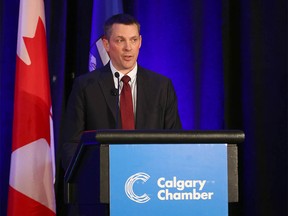While providing gasoline tax relief will cost the treasury some money, higher oil prices will pump out far more cash for the government

Article content
Alberta’s finance minister got a helping hand over the weekend from the Organization of Petroleum Exporting Countries (OPEC), although it could end up costing the treasury hundreds of millions of dollars.
For Alberta consumers, however, it could mean some continued pocketbook relief, in the form of a lower provincial fuel tax.
Article content
On Sunday, OPEC and its partners agreed to extend significant output cuts until the end of June, taking about two million barrels per day (bpd) out of the global production mix.
Advertisement 2
Article content
On Monday, benchmark U.S. West Texas Intermediate (WTI) crude briefly punched above the US$80-per-barrel threshold, before closing the day at $78.74 a barrel.
Alberta Finance Minister Nate Horner’s new budget, released last week, forecasts a thin $367-million surplus, while projecting WTI crude prices will average $74 a barrel.
The budget for the new fiscal year, which starts April 1, doesn’t project the government will provide any tax relief at the pumps for consumers — based on a formula that is tied to oil prices.
The provincial fuel tax was partially reinstated in January at nine cents a litre — after being taken off entirely throughout 2023 — and is projected to be headed back to a full 13 cents this spring.
However, $80 is the magic point in the province’s formula when some relief kicks in.
“I don’t think that’ll be a bad thing if that is the outcome,” Horner told reporters Monday after speaking to the Calgary Chamber of Commerce.
“Boy, I hope that’s what happens. The beauty of the fuel tax relief program is that it pays for itself. Once oil gets over $80, we take in so much more in royalty revenue that it’s easy to justify.”
Article content
Advertisement 3
Article content
Recommended from Editorial
Indeed, while providing gasoline tax relief will cost the treasury some money, higher oil prices will pump out far more cash for the government.
The budget projection for WTI is $3-a-barrel below the average of more than a dozen private-sector forecasters that the provincial government monitors.
Every $1-per-barrel increase in oil prices over the course of the year boosts provincial revenues by $630 million.
“If it had the potential to stay there (at $80 a barrel) for the year, that would be an extra $3 billion and change,” Horner added.
“We wouldn’t be borrowing in this year and potentially we’d have a lot more opportunities at the end of the year.”
The fuel tax rebate program is set each quarter, with the upcoming rebate for the April-to-June period to be announced before the end of this month. (The average price will be based on 20 trading days for WTI crude, that lead up to March 15.)
Advertisement 4
Article content
It is designed to provide Alberta motorists a break when oil prices are high and churning out more money for provincial coffers.
The current nine-cent-a-litre tax will remain in place until at least March 31, instead of the full 13 cents. The province says this reduction will save consumers $124 million during the first three months of this year.
If oil averages below $80 a barrel, the full fuel tax will be reimposed.
However, if crude prices average between $80 and $85, the levy is set at nine cents, falling to 4.5 cents if WTI is between $85 and $90.
And the entire tax is removed if oil prices are above $90 a barrel.
The tax on gasoline and diesel had been fully suspended throughout 2023.

With the full tax expected to be in place, the new budget projects that fuel tax revenue for the government will be $1.2 billion higher than in 2023.
However, oil prices are notoriously difficult to project and are affected by a range of supply-demand and geopolitical factors.
On Sunday, members of OPEC+ announced they will extend their voluntary cuts of 2.2 million through the second quarter to support “the stability and balance of oil markets.”
Advertisement 5
Article content
The reductions include one million barrels per day from OPEC kingpin Saudi Arabia, along with 471,000 bpd from Russia and 220,000 bpd from Iraq.
Oil markets have been trading between $70 and $80 since mid-December, amid uncertainty about overall demand levels in 2024.
“This new move by OPEC+ clearly shows strong unity within the group,” Rystad Energy senior vice-president Jorge Leon said in a statement.
“It also shows robust determination to defend a price floor above $80 per barrel in the second quarter.”
The International Energy Agency says global oil demand is slowing — particularly from China — and will only increase by 1.2 million bpd in 2024, down from 2.3 million barrels last year.
However, OPEC is forecasting much more robust consumption growth of 2.2 million bpd.

Without the expected extension of the OPEC+ cuts, crude markets would have been set to fall, said Rory Johnston, founder of the Commodity Context newsletter
“This kind of high $70s to low $80s (price) is pretty sustainable at this point,” he said.
Johnston believes there is about a 30 per cent chance that WTI oil prices will be above $80 and Alberta’s fuel tax rebate will partially kick in during the new budget year.
Meanwhile, Alberta oil producers are expecting the cartel’s cut should help provide a floor to oil markets in 2024.
Surge Energy CEO Paul Colborne said with demand rising to record levels — and bolstered during the summer driving season — he expects oil prices will trade between $75 and $90 a barrel in the next three to six months.
“These cuts just keep the market tight while we’re waiting here,” Colborne said.
“If you are an oily company, it’s a healthy time.”
Chris Varcoe is a Calgary Herald columnist.
Article content






